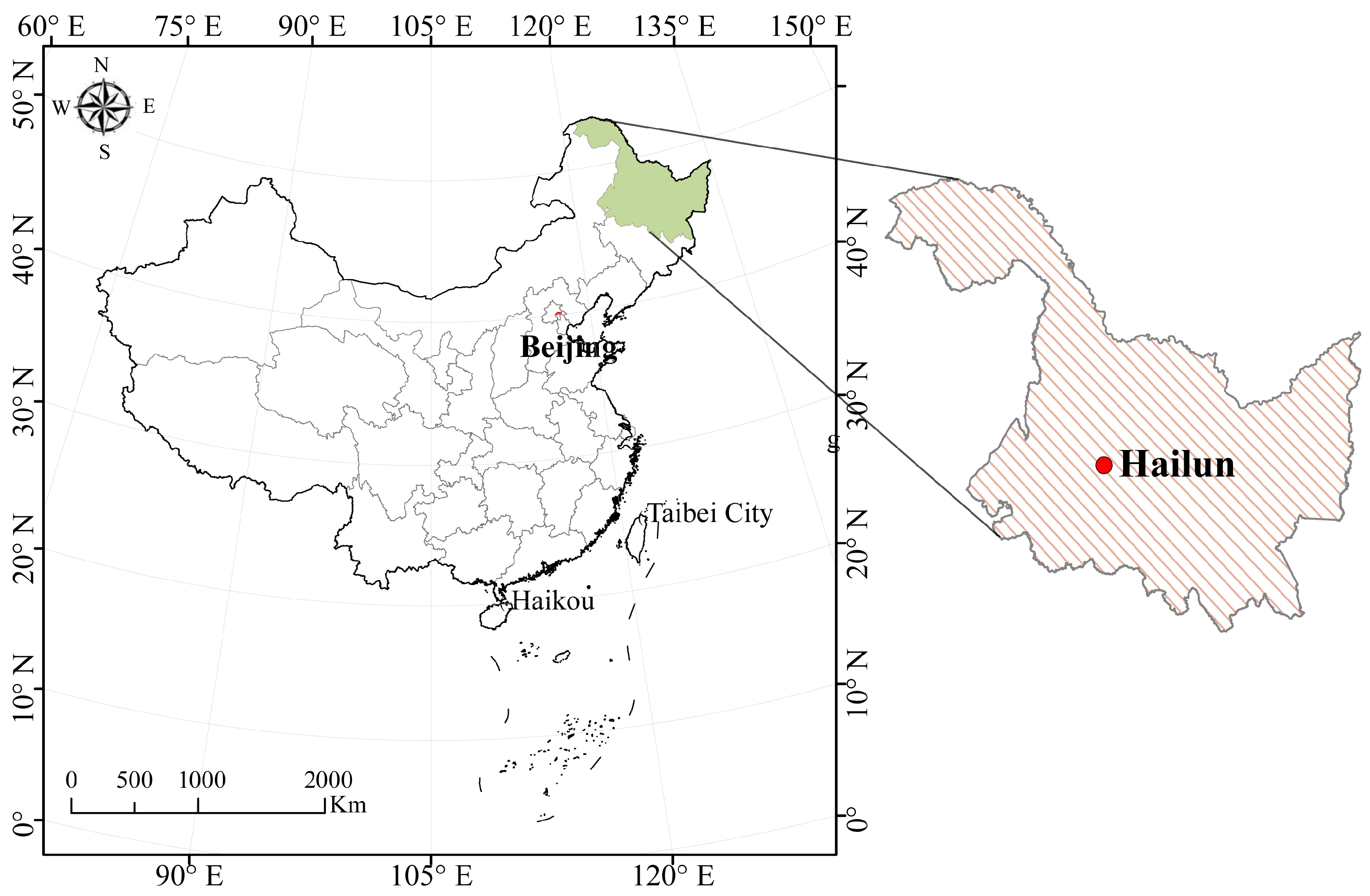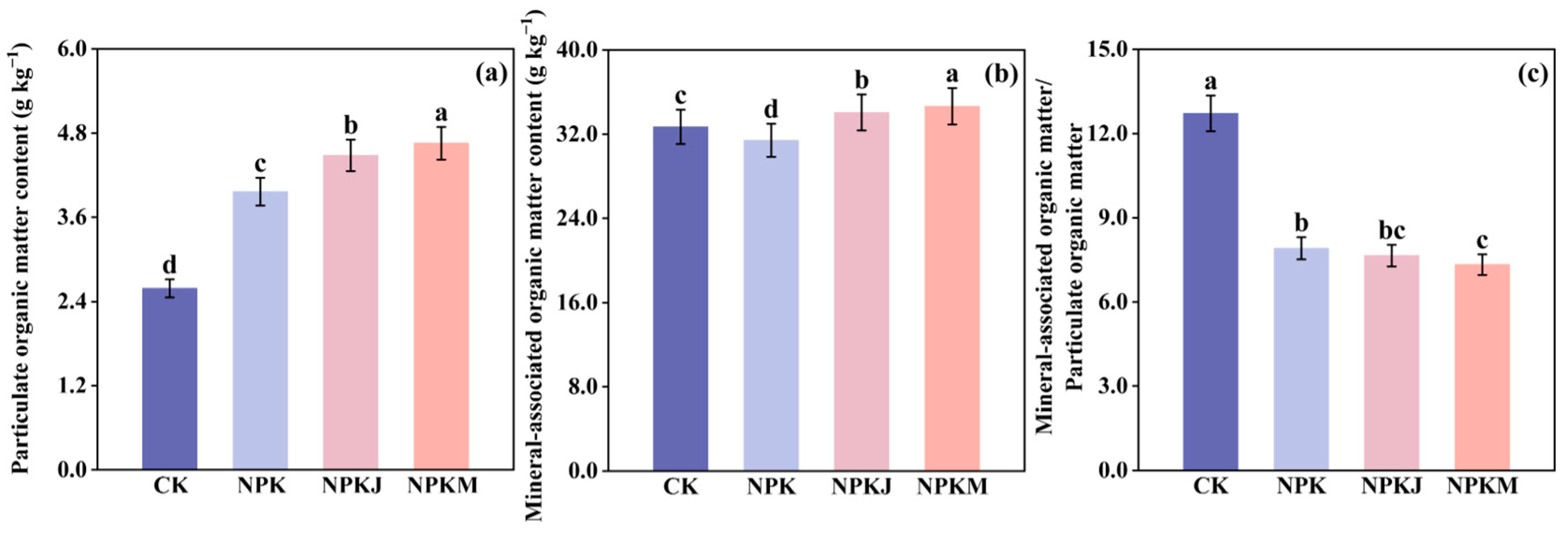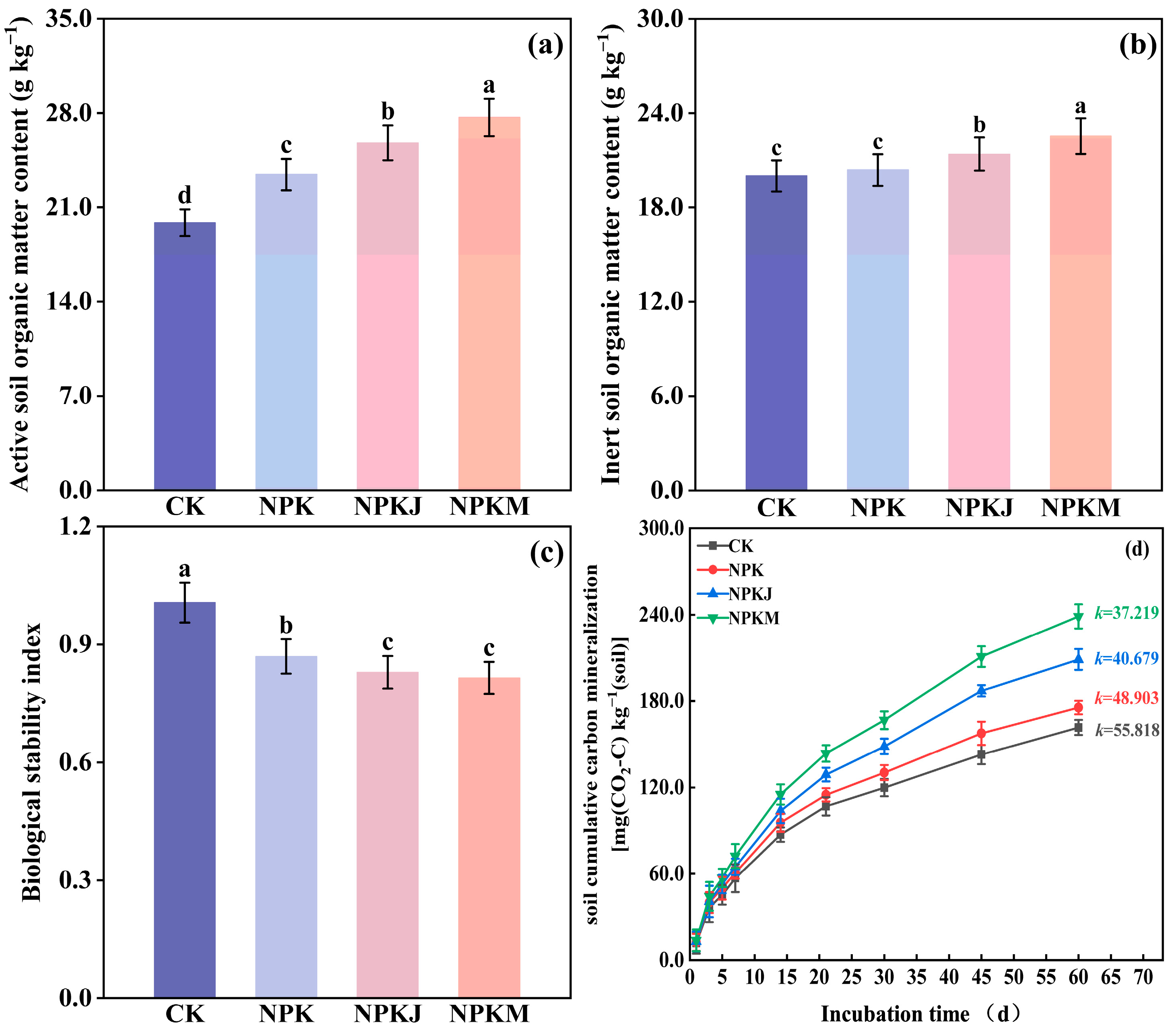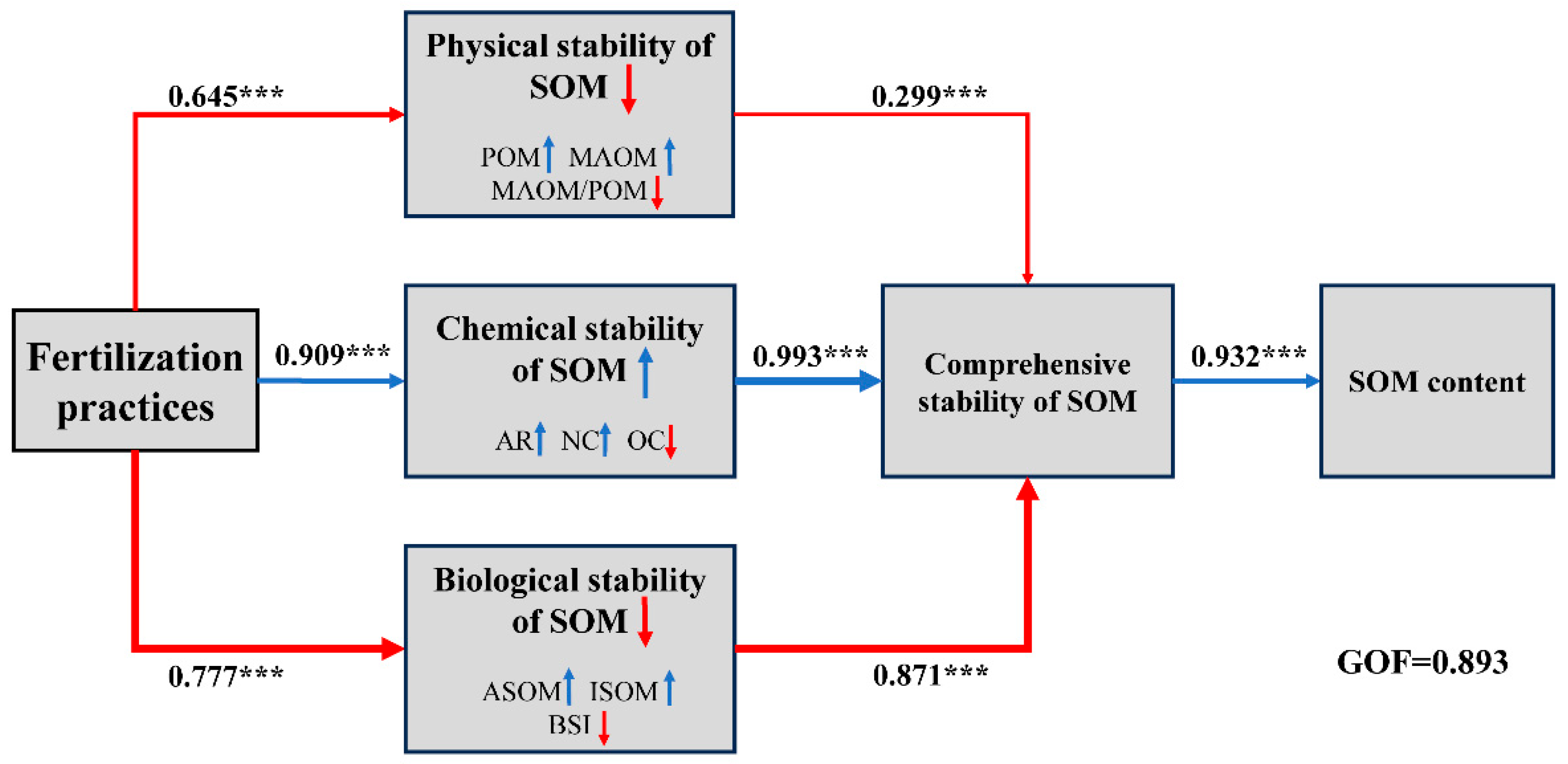Effect of Long-Term Fertilization Practices on the Stability of Soil Organic Matter in the Northeast Black Soil Region in China
Abstract
:1. Introduction
2. Materials and Methods
2.1. Experimental Site
2.2. Experimental Design and Field Management
2.3. Soil Sampling
2.4. Laboratory Methods
2.4.1. SOC, POM, and MAOM
2.4.2. Soil Organic Compounds
2.4.3. Soil Mineralization Rate Constant
2.5. SOM Stability Indexes
2.6. Statistical Analysis
3. Results
3.1. Physical Stability of SOM
3.2. Chemical Stability of SOM
3.3. Biological Stability of SOM
3.4. The Content and Comprehensive Stability of SOM
4. Discussion
4.1. Effects of Fertilization Practices on the Physical Stability of SOM
4.2. Effects of Fertilization Practices on the Chemical Stability of SOM
4.3. Effects of Fertilization Practices on Biological Stability of SOM
4.4. Effects of Fertilization Practices on the Content and Comprehensive Stability of SOM
5. Conclusions
Author Contributions
Funding
Data Availability Statement
Conflicts of Interest
References
- Amelung, W.; Bossio, D.; de Vries, W.; Kögel-Knabner, I.; Lehmann, J.; Amundson, R.; Bol, R.; Collins, C.; Lal, R.; Leifeld, J.; et al. Towards a global-scale soil climate mitigation strategy. Nat. Commun. 2020, 11, 5427. [Google Scholar] [CrossRef] [PubMed]
- Bilalis, D.; Kalivas, A.; Karydogianni, S.; Folina, A.; Ζisi, C.; Kakabouki, I.; Tabaxi, I. Effect of organic fertilization on soil characteristics, yield and quality of Virginia Tobacco in Mediterranean area. Emir. J. Food Agric. 2020, 32, 610–616. [Google Scholar] [CrossRef]
- Mayer, M.; Leifeld, J.; Szidat, S.; Mäder, P.; Krause, H.-M.; Steffens, M. Dynamic stability of mineral-associated organic matter: Enhanced stability and turnover through organic fertilization in a temperate agricultural topsoil. Soil Biol. Biochem. 2023, 184, 109095. [Google Scholar] [CrossRef]
- Atere, C.T.; Gunina, A.; Zhu, Z.; Xiao, M.; Liu, S.; Kuzyakov, Y.; Chen, L.; Deng, Y.; Wu, J.; Ge, T. Organic matter stabilization in aggregates and density fractions in paddy soil depending on long-term fertilization: Tracing of pathways by 13C natural abundance. Soil Biol. Biochem. 2020, 149, 107931. [Google Scholar] [CrossRef]
- Liliana, V.J.; Gutierrez Boem, F.; Garcia, F.; Rubio, G. Long-term fertilization does not affect soil carbon/nitrogen/sulfur ratios or the proportion between labile and nonlabile fractions in Mollisols. Soil Sci. Soc. Am. J. 2020, 84, 798–810. [Google Scholar] [CrossRef]
- Li, G.; Li, H.; Yi, X.; Hu, Z.; Ni, K.; Ruan, J.; Yang, Y. Effects of Fertilization Regimes on Soil Organic Carbon Fractions and Its Mineralization in Tea Gardens. Agronomy 2022, 12, 2522. [Google Scholar] [CrossRef]
- Chen, L.; Liu, L.; Qin, S.; Yang, G.; Fang, K.; Zhu, B.; Kuzyakov, Y.; Chen, P.; Xu, Y.; Yang, Y. Regulation of priming effect by soil organic matter stability over a broad geographic scale. Nat. Commun. 2019, 10, 5112. [Google Scholar] [CrossRef]
- Bhogal, A.; Nicholson, F.A.; Rollett, A.; Taylor, M.; Litterick, A.; Whittingham, M.J.; Williams, J.R. Improvements in the Quality of Agricultural Soils Following Organic Material Additions Depend on both the Quantity and Quality of the Materials Applied. Front. Sustain. Food Syst. 2018, 2, 9. [Google Scholar] [CrossRef]
- Sokolov, D.A.; Dmitrevskaya, I.I.; Pautova, N.B.; Lebedeva, T.N.; Chernikov, V.A.; Semenov, V.M. A Study of Soil Organic Matter Stability Using Derivatography and Long-Term Incubation Methods. Eurasian Soil Sci. 2021, 54, 487–498. [Google Scholar] [CrossRef]
- Yu, W.; Huang, W.; Weintraub-Leff, S.R.; Hall, S.J. Where and why do particulate organic matter (POM) and mineral-associated organic matter (MAOM) differ among diverse soils? Soil Biol. Biochem. 2022, 172, 108756. [Google Scholar] [CrossRef]
- Zhou, H.; Lin, Y.; Fang, F.; Yin, L.; Ge, L.; Chen, H.; Li, S.; Yao, Y. Process and mechanism of complexation of dissolved organic matter(DOM)and Cu~(2+) in paddy soil. J. Agro-Environ. Sci. 2023, 42, 1071–1081. [Google Scholar]
- Zhang, Z.; Wang, J.J.; Lyu, X.; Jiang, M.; Bhadha, J.; Wright, A. Impacts of land use change on soil organic matter chemistry in the Everglades, Florida—A characterization with pyrolysis-gas chromatography–mass spectrometry. Geoderma 2019, 338, 393–400. [Google Scholar] [CrossRef]
- Song, F.; Hu, N.; Lou, Y.; Zhang, H.; Zhu, P.; Li, D.; Gao, H.; Zhang, S.; Wang, Y. Divergent chemical compositions of soil organic matter size fractions under long-term amendments across a climate gradient. Soil Tillage Res. 2024, 242, 106156. [Google Scholar] [CrossRef]
- Wang, Z.; Ma, S.; Hu, Y.; Chen, Y.; Jiang, H.; Duan, B.; Lu, X. Links between chemical composition of soil organic matter and soil enzyme activity in alpine grassland ecosystems of the Tibetan Plateau. Catena 2022, 218, 106565. [Google Scholar] [CrossRef]
- Dieckow, J.; Mielniczuk, J.; González-Vila, F.J.; Knicker, H.; Bayer, C. No-till cropping systems and N fertilisation influences on organic matter composition of physical fractions of a subtropical Acrisol as assessed by analytical pyrolysis (Py-GC/MS). Geoderma 2006, 135, 260–268. [Google Scholar] [CrossRef]
- San-Emeterio, L.M.; López-Núñez, R.; González-Vila, F.J.; González-Pérez, J.A. Evolution of Composting Process in Maize Biomass Revealed by Analytical Pyrolysis (Py-GC/MS) and Pyrolysis Compound Specific Isotope Analysis (Py-CSIA). Appl. Sci. 2021, 11, 6684. [Google Scholar] [CrossRef]
- Drosos, M.; Orlando, M.; Cozzolino, V.; Scopa, A.; Piccolo, A. Deriving the Shannon Index from the soil molecular Humeome serves as a descriptor of soil organic matter stability under different cropping systems. Chem. Biol. Technol. Agric. 2023, 10, 105. [Google Scholar] [CrossRef]
- Cai, Y.; Wang, Z.; Cui, L.; Wang, J.; Zuo, X.; Lei, Y.; Zhao, X.; Zhai, X.; Li, J.; Li, W. Distribution, source diagnostics, and factors influencing polycyclic aromatic hydrocarbons in the Yellow River Delta wetland. Reg. Stud. Mar. Sci. 2023, 67, 103181. [Google Scholar] [CrossRef]
- Just, C.; Armbruster, M.; Barkusky, D.; Baumecker, M.; Diepolder, M.; Döring, T.F.; Heigl, L.; Honermeier, B.; Jate, M.; Merbach, I.; et al. Soil organic carbon sequestration in agricultural long-term field experiments as derived from particulate and mineral-associated organic matter. Geoderma 2023, 434, 116472. [Google Scholar] [CrossRef]
- Semenov, V.M.; Lebedeva, T.N.; Zinyakova, N.B.; Sokolov, D.A. Sizes and Ratios of Organic Carbon Pools in Gray Forest Soil under Long-Term Application of Mineral and Organic Fertilizers. Eurasian Soil Sci. 2023, 56, 470–487. [Google Scholar] [CrossRef]
- Qu, J.; Liu, Y.; Xu, X.; Meng, X.; Sun, Y. Effects of application of microbial and organic fertilizer on soil fertility and crop yield of a black soil in China. Agrochimica 2020, 64, 223–238. [Google Scholar] [CrossRef]
- Zhang, X.; Zhao, Y.; Meng, H.; Li, L.; Cui, H.; Wei, Z.; Yang, T.; Dang, Q. Revealing the Inner Dynamics of Fulvic Acid from Different Compost-Amended Soils through Microbial and Chemical Analyses. J. Agric. Food Chem. 2020, 68, 3722–3728. [Google Scholar] [CrossRef]
- Feng, H.; Han, X.; Zhu, Y.; Zhang, M.; Ji, Y.; Lu, X.; Chen, X.; Yan, J.; Zou, W. Effects of long-term application of organic materials on soil water extractable organic matter, fulvic acid, humic acid structure and microbial driving mechanisms. Plant Soil 2024, 501, 323–341. [Google Scholar] [CrossRef]
- Cui, J.; Wei, L.; Zhu, Z.; Deng, Y.; Chen, S.; Kuzyakov, Y.; Ge, T. Influence of soil N availability on priming effects depending on temperature. Soil Tillage Res. 2024, 242, 106163. [Google Scholar] [CrossRef]
- Peltre, C.; Fernández, J.M.; Craine, J.M.; Plante, A.F. Relationships between Biological and Thermal Indices of Soil Organic Matter Stability Differ with Soil Organic Carbon Level. Soil Sci. Soc. Am. J. 2013, 77, 2020–2028. [Google Scholar] [CrossRef]
- Guerrini, I.A.; da Silva, J.P.; Lozano Sivisaca, D.C.; de Moraes, F.G.; Puglla, C.A.Y.; de Melo Silva Neto, C.; Barroca Silva, R.; Pereira Justino, S.T.; Roder, L.R.; James, J.N.; et al. Evaluating carbon stocks in soils of fragmented Brazilian Atlantic Forests (BAF) based on soil features and different methodologies. Sci. Rep. 2024, 14, 10007. [Google Scholar] [CrossRef] [PubMed]
- Gessesse, T.A.; Khamzina, A. How reliable is the Walkley-Black method for analyzing carbon-poor, semi-arid soils in Ethiopia? J. Arid Environ. 2018, 153, 98–101. [Google Scholar] [CrossRef]
- Wu, L.; Song, Z.; Wu, Y.; Xia, S.; Kuzyakov, Y.; Hartley, I.P.; Fang, Y.; Yu, C.; Wang, Y.; Chen, J.; et al. Organic matter composition and stability in estuarine wetlands depending on soil salinity. Sci. Total Environ. 2024, 945, 173861. [Google Scholar] [CrossRef]
- Yan, M.; Zhang, X.; Liu, K.; Lou, Y.; Wang, Y. Particle size primarily shifts chemical composition of organic matter under long-term fertilization in paddy soil. Eur. J. Soil Sci. 2021, 73, e13170. [Google Scholar] [CrossRef]
- Sun, Z.; Quénéa, K.; Delarue, F.; Anquetil, C.; Ravelojaona, H.; Sebag, D.; Eon, L.; Kowalewski, I. Combining Rock-Eval® thermal analysis and thermochemolysis to evaluate the influence of forest management on soil organic matter quality and stability. Org. Geochem. 2023, 179, 104585. [Google Scholar] [CrossRef]
- Becker, J.N.; Dippold, M.A.; Hemp, A.; Kuzyakov, Y. Ashes to ashes: Characterization of organic matter in Andosols along a 3400 m elevation transect at Mount Kilimanjaro using analytical pyrolysis. Catena 2019, 180, 271–281. [Google Scholar] [CrossRef]
- Yang, X.; Xiong, J.; Du, T.; Ju, X.; Gan, Y.; Li, S.; Xia, L.; Shen, Y.; Pacenka, S.; Steenhuis, T.S.; et al. Diversifying crop rotation increases food production, reduces net greenhouse gas emissions and improves soil health. Nat. Commun. 2024, 15, 198. [Google Scholar] [CrossRef] [PubMed]
- Kauer, K.; Pärnpuu, S.; Talgre, L.; Eremeev, V.; Luik, A. Soil Particulate and Mineral-Associated Organic Matter Increases in Organic Farming under Cover Cropping and Manure Addition. Agriculture 2021, 11, 903. [Google Scholar] [CrossRef]
- Mayer, M.; Krause, H.-M.; Fliessbach, A.; Mader, P.; Steffens, M. Fertilizer quality and labile soil organic matter fractions are vital for organic carbon sequestration in temperate arable soils within a long-term trial in Switzerland. Geoderma 2022, 426, 116080. [Google Scholar] [CrossRef]
- Derenne, S.; Quénéa, K. Analytical pyrolysis as a tool to probe soil organic matter. J. Anal. Appl. Pyrolysis 2015, 111, 108–120. [Google Scholar] [CrossRef]
- Wang, H.; Zhong, L.; Liu, J.; Liu, X.; Xue, W.; Liu, X.; Yang, H.; Shen, Y.; Li, J.; Sun, Z. Systematic Analysis of the Effects of Different Green Manure Crop Rotations on Soil Nutrient Dynamics and Bacterial Community Structure in the Taihu Lake Region, Jiangsu. Agriculture 2024, 14, 1017. [Google Scholar] [CrossRef]
- Ren, F.; Misselbrook, T.H.; Sun, N.; Zhang, X.; Zhang, S.; Jiao, J.; Xu, M.; Wu, L. Spatial changes and driving variables of topsoil organic carbon stocks in Chinese croplands under different fertilization strategies. Sci. Total Environ. 2021, 767, 144350. [Google Scholar] [CrossRef]
- Liu, S.; Li, H.; Xie, X.; Chen, Y.; Lang, M.; Chen, X. Long-term moderate fertilization increases the complexity of soil microbial community and promotes regulation of phosphorus cycling genes to improve the availability of phosphorus in acid soil. Appl. Soil Ecol. 2024, 194, 105178. [Google Scholar] [CrossRef]
- Zani, C.F.; Manning, D.A.C.; Abbott, G.D.; Taylor, J.A.; Cooper, J.; Lopez-Capel, E. Diversified crop rotations and organic amendments as strategies for increasing soil carbon storage and stabilisation in UK arable systems. Front. Environ. Sci. 2023, 11, 1113026. [Google Scholar] [CrossRef]
- Feng, M.; Liu, K.; Lou, Y.; Shang, Y.; Guo, C.; Song, Z.; Gunina, A.; Wang, Y. Different biochemical composition and oxidation state of soil organic matter between upland and paddy fields. J. Soils Sediments 2024, 24, 1920–1932. [Google Scholar] [CrossRef]
- Ni, H.; Jing, X.; Xiao, X.; Zhang, N.; Wang, X.; Sui, Y.; Sun, B.; Liang, Y. Microbial metabolism and necromass mediated fertilization effect on soil organic carbon after long-term community incubation in different climates. ISME J 2021, 15, 2561–2573. [Google Scholar] [CrossRef] [PubMed]
- Kuśmierz, S.; Skowrońska, M.; Tkaczyk, P.; Lipiński, W.; Mielniczuk, J. Soil Organic Carbon and Mineral Nitrogen Contents in Soils as Affected by Their pH, Texture and Fertilization. Agronomy 2023, 13, 267. [Google Scholar] [CrossRef]
- Zhu, Z.; Zhou, J.; Shahbaz, M.; Tang, H.; Liu, S.; Zhang, W.; Yuan, H.; Zhou, P.; Alharbi, H.; Wu, J.; et al. Microorganisms maintain C:N stoichiometric balance by regulating the priming effect in long-term fertilized soils. Appl. Soil Ecol. 2021, 167, 104033. [Google Scholar] [CrossRef]
- Liang, J.; Shi, X.; Zhang, T.; An, H.; Hou, J.; Lan, H.; Zhao, P.; Hou, D.; Zhang, S.; Zhang, J. Response of Soil Bacterial Communities and Potato Productivity to Fertilizer Application in Farmlands in the Agropastoral Zone of Northern China. Agronomy 2024, 14, 1432. [Google Scholar] [CrossRef]
- Tian, J.; Lou, Y.; Gao, Y.; Fang, H.; Liu, S.; Xu, M.; Blagodatskaya, E.; Kuzyakov, Y. Response of soil organic matter fractions and composition of microbial community to long-term organic and mineral fertilization. Biol. Fertil. Soils 2017, 53, 523–532. [Google Scholar] [CrossRef]
- Chen, S.; Dong, H.; Hong, Y.; Gao, F.; Guo, S.; Mi, W. Long-term different fertilization practices restructured the functional carbon pools in a paddy soil through distinct mechanisms. Agric. Ecosyst. Environ. 2024, 374, 109168. [Google Scholar] [CrossRef]






| pH | SOC | Sand | Silt | Clay |
|---|---|---|---|---|
| g kg−1 | g kg−1 | g kg−1 | g kg−1 | |
| 6.2 | 25.7 | 250 | 340 | 410 |
| Treatments | CK | NPK | NPKJ | NPKM |
|---|---|---|---|---|
| AI | 22.79 ± 1.52 a | 21.65 ± 2.76 b | 18.30 ± 1.31 c | 17.66 ± 1.04 c |
| UH | 49.00 ± 2.32 b | 52.26 ± 5.17 a | 47.91 ± 4.70 c | 43.97 ± 3.21 d |
| OC | 21.43 ± 3.44 a | 15.45 ± 2.77 c | 18.57 ± 4.51 b | 18.04 ± 3.90 b |
| AR | 2.15 ± 0.61 d | 3.15 ± 0.27 c | 5.59 ± 0.79 b | 9.25 ± 1.13 a |
| NC | 3.02 ± 0.27 d | 5.66 ± 0.46 c | 8.08 ± 0.52 b | 9.45 ± 0.81 a |
| SI | 0.14 ± 0.04 d | 0.26 ± 0.07 c | 0.32 ± 0.06 b | 0.47 ± 0.08 a |
| OT | 1.47 ± 0.12 b | 1.57 ± 0.22 a | 1.23 ± 0.53 c | 1.16 ± 0.17 c |
Disclaimer/Publisher’s Note: The statements, opinions and data contained in all publications are solely those of the individual author(s) and contributor(s) and not of MDPI and/or the editor(s). MDPI and/or the editor(s) disclaim responsibility for any injury to people or property resulting from any ideas, methods, instructions or products referred to in the content. |
© 2024 by the authors. Licensee MDPI, Basel, Switzerland. This article is an open access article distributed under the terms and conditions of the Creative Commons Attribution (CC BY) license (https://creativecommons.org/licenses/by/4.0/).
Share and Cite
Ji, Y.; Zhao, Y.; Han, X.; Chen, X.; Yan, J.; Lu, X.; Zhu, Y.; Zou, W. Effect of Long-Term Fertilization Practices on the Stability of Soil Organic Matter in the Northeast Black Soil Region in China. Agronomy 2024, 14, 2272. https://doi.org/10.3390/agronomy14102272
Ji Y, Zhao Y, Han X, Chen X, Yan J, Lu X, Zhu Y, Zou W. Effect of Long-Term Fertilization Practices on the Stability of Soil Organic Matter in the Northeast Black Soil Region in China. Agronomy. 2024; 14(10):2272. https://doi.org/10.3390/agronomy14102272
Chicago/Turabian StyleJi, Yuxuan, Ying Zhao, Xiaozeng Han, Xu Chen, Jun Yan, Xinchun Lu, Yuanchen Zhu, and Wenxiu Zou. 2024. "Effect of Long-Term Fertilization Practices on the Stability of Soil Organic Matter in the Northeast Black Soil Region in China" Agronomy 14, no. 10: 2272. https://doi.org/10.3390/agronomy14102272





